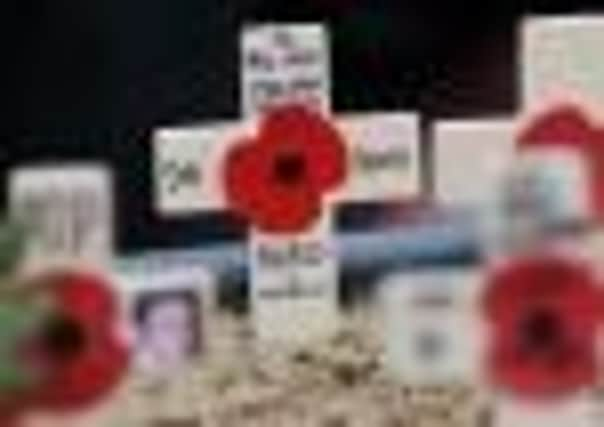Why we need to take two minutes to remember the dead


LAST month, the oldest surviving Battle of Britain pilot, Flight Lieutenant William Walker, died at the age of 99.
His passing comes three years after Harry Patch, the last British survivor of the carnage of the Western Front, died aged 111. A humble plumber from Somerset, he was the final physical link to a conflict that saw millions bogged down in the mud of Flanders and northern France for more than four years.
Advertisement
Hide AdAdvertisement
Hide AdTheir deaths are a reminder to us that as the distance between ourselves and these devastating conflicts grows, so the number of voices who bore witness to them dwindles ever smaller. There will come a time when there is no one left alive who fought in the Second World War, just as there will be no-one left who survived the horrors of Auschwitz and the Nazi concentration camps.
For generations of Britons, the words “the 11th hour of the 11th day of the 11th month” are etched into memory along with lines from war poems such as Wilfred Owen’s Dulce Et Decorum Est. But as the memories fade and first-hand accounts of the horrors of these conflicts become confined to history books and TV documentaries, the reason we still remember those who lost their lives can become less clear – especially to a younger generation for whom wars are played out in computer games, or by actors on the big screen.
Rather than fading away, though, awareness of Remembrance Day seems to have grown in recent years. Last month David Cameron announced a major national commemoration to mark the centenary of the First World War in 2014, with thousands of schoolchildren getting the chance to visit battlefields like the Somme, Verdun and Fromelles as part of a £5m educational programme.
And now the Royal British Legion has launched a campaign to extend Remembrance Sunday’s two-minute silence to the online community, with thousands of Facebook and Twitter users being encouraged to observe the silence using Thunderclap, a new social media tool that allows users to simultaneously send the same message.
Advertisement
Hide AdAdvertisement
Hide AdThe Royal British Legion, which claims it is the first UK organisation to use a social media tool to encourage the public to mark the two-minute silence, is asking people to go to its website at www.britishlegion.org.uk and click on the link to the Two Minute Silence Thunderclap page.
They can show their support by clicking to authorise their Twitter and Facebook accounts to send the tweet or message that reads “I’ll be remembering the fallen at 11 o’clock #2MinuteSilence #LestWeForget” at 9am on Sunday.
The charity hopes thousands of the UK’s estimated 10 million Twitter and 33 million Facebook users will take part. “We hope to create the largest ever show of online Remembrance by using the communicative power of social media to remind millions of Britons that they have a very personal opportunity to honour the men and women who paid the ultimate sacrifice,” says Helen Hill, head of Remembrance at RBL.
The act of observing a two minute silence began in 1919, following the Armistice signed at 11am on November 11 the previous year, which marked the end of the First World War.
Advertisement
Hide AdAdvertisement
Hide AdThe nature of war has changed a great deal since then, and subsequent conflicts have created new generations of veterans. This year marked the 30th anniversary of the Falklands War, while the fighting in Iraq and the continuing British casualties in Afghanistan serve as a sombre reminder of the continuing cost of warfare.
More than three-quarters of the UK population are expected to observe the silence this coming Sunday and Bethan Herbert, a spokeswoman for the Royal British Legion, says its online campaign is not simply aimed at raising awareness among the younger generation.
“It’s not only young people that use social media, it’s relevant to a wider audience as well, and it’s important that we get the message across to as many people as possible,” she says.
Remembrance Day isn’t simply about commemorating the past either.
Advertisement
Hide AdAdvertisement
Hide Ad“It’s not just about World War One and World War Two but recent conflicts like Iraq and Afghanistan. Young people can serve from the age of 16 and are able to fight not long afterwards and there are a lot of young people who are in the forces so it is still relevant.
“It’s an act of remembrance for those who paid the ultimate price and those that are still paying that price in conflicts today.”